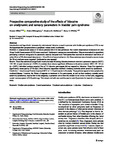Prospective comparative study of the effects of lidocaine on urodynamic and sensory parameters in bladder pain syndrome
| dc.contributor.author | Offiah, I | |
| dc.contributor.author | Dilloughery, E | |
| dc.contributor.author | McMahon, SB | |
| dc.contributor.author | O’Reilly, BA | |
| dc.date.accessioned | 2022-02-17T13:54:39Z | |
| dc.date.issued | 2019-03-14 | |
| dc.identifier.issn | 0937-3462 | |
| dc.identifier.issn | 1433-3023 | |
| dc.identifier.uri | http://hdl.handle.net/10026.1/18812 | |
| dc.description.abstract |
Introduction and hypothesis Intravesically administered lidocaine is used in patients with bladder pain syndrome (BPS) to test the hypothesis that symptoms have a peripheral versus central mechanism. Methods A cross-sectional study of 24 female patients with BPS was performed. The Central Sensitisation Inventory (CSI) and Kings Health Questionnaire (KHQ) were completed. Urodynamic assessment was undertaken. Women were asked to report their pain using a numeric rating scale at cystometric capacity and post void. Participants then received an intravesical instillation of either 20 ml of 2% alkalinised lidocaine (n = 16) or 20 ml of normal saline (n = 8). These solutions were allowed to remain in situ for 20 min and pain score repeated. Urodynamics was repeated. Results There was a statistically significant volume increase following lidocaine treatment: maximal cystometric capacity (MCC) 192–261 ml post lidocaine (p = 0.005.) In contrast, there was no significant difference in the saline controls: MCC 190–183 ml (p = 0.879.) Individual analysis revealed five of 16 lidocaine participants did not respond to lidocaine. These five reported a significantly worse quality of life (QoL) than lidocaine responders and had a tendency towards central sensitivity syndromes. Conclusion Lidocaine significantly improved MCC in 11/16 participants in this study. These patients appear to have peripherally mediated disease. However, the failure of response to treatment in five participants, as well as their tendency towards central sensitivity syndromes, implies that in this subgroup, a peripheral drive from the bladder is not critical to their pain, suggesting central nervous system (CNS) pathology. This simple and safe test could be used to stratify patients for research or therapeutic trials. | |
| dc.format.extent | 1293-1301 | |
| dc.format.medium | Print-Electronic | |
| dc.language | en | |
| dc.language.iso | en | |
| dc.publisher | Springer Science and Business Media LLC | |
| dc.subject | Bladder pain syndrome | |
| dc.subject | Central sensitisation | |
| dc.subject | Peripheral pain modulation | |
| dc.subject | Lidocaine | |
| dc.subject | Urodynamics | |
| dc.title | Prospective comparative study of the effects of lidocaine on urodynamic and sensory parameters in bladder pain syndrome | |
| dc.type | journal-article | |
| dc.type | Article | |
| plymouth.author-url | https://www.ncbi.nlm.nih.gov/pubmed/30874834 | |
| plymouth.issue | 8 | |
| plymouth.volume | 30 | |
| plymouth.publication-status | Published | |
| plymouth.journal | International Urogynecology Journal | |
| dc.identifier.doi | 10.1007/s00192-019-03892-2 | |
| plymouth.organisational-group | /Plymouth | |
| plymouth.organisational-group | /Plymouth/Faculty of Health | |
| plymouth.organisational-group | /Plymouth/Faculty of Health/Peninsula Medical School | |
| plymouth.organisational-group | /Plymouth/REF 2021 Researchers by UoA | |
| plymouth.organisational-group | /Plymouth/REF 2021 Researchers by UoA/UoA01 Clinical Medicine | |
| plymouth.organisational-group | /Plymouth/Users by role | |
| plymouth.organisational-group | /Plymouth/Users by role/Academics | |
| plymouth.organisational-group | /Plymouth/Users by role/Researchers in ResearchFish submission | |
| dc.publisher.place | England | |
| dcterms.dateAccepted | 2019-01-25 | |
| dc.rights.embargodate | 2022-2-18 | |
| dc.identifier.eissn | 1433-3023 | |
| dc.rights.embargoperiod | Not known | |
| rioxxterms.funder | National Institute for Health Research | |
| rioxxterms.identifier.project | NIHR Clinical Lectureship | |
| rioxxterms.versionofrecord | 10.1007/s00192-019-03892-2 | |
| rioxxterms.licenseref.uri | http://www.rioxx.net/licenses/all-rights-reserved | |
| rioxxterms.licenseref.startdate | 2019-03-14 | |
| rioxxterms.type | Journal Article/Review | |
| plymouth.funder | NIHR Clinical Lectureship::National Institute for Health Research |


